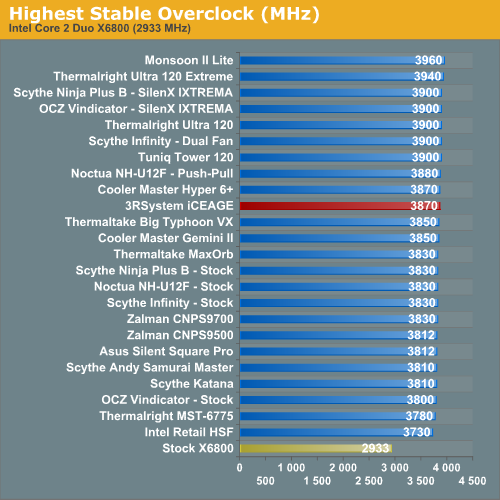3RSystem iCEAGE: A New Cooling Company Tackles the Heatpipe Tower
by Wesley Fink on June 21, 2007 12:02 AM EST- Posted in
- Cases/Cooling/PSUs
Overclocking
As cooling solutions do a better job of keeping the CPU at a lower temperature, it is reasonable to expect the overclocking capabilities of the CPU will increase. In each test of a cooler we measure the highest stable overclock of a standard X6800 processor under the following conditions:
CPU Multiplier: 14x (Stock 11x)
CPU voltage: 1.5875V
FSB Voltage: 1.30V
Memory Voltage: 2.20V
nForce SPP Voltage: 1.35V
nForce MCP Voltage: 1.7V
HT nForce SPP <-> MCP: Auto
Memory is set to Auto timings on the 680i and memory speed is linked to the FSB for the overclocking tests. This removes memory as any kind of impediment to the maximum stable overclock. Linked settings on the 680i are a 1066FSB to a DDR2 memory speed of DDR2-800. As the FSB is raised the linked memory speed increases in proportion. The same processor is used in all cooling tests to ensure comparable results.

The 3RSystem iCEAGE reached a stable 3.87 GHz, which is similar to other second tier heatpipe towers. This is better than any down-facing cooler and just below the 3.90GHz to 3.94GHz of the top performing heatpipe towers. This is comparable to several other heatpipe towers tested with just one fan. The performance is competent but doesn't lead the pack with the top heatpipe towers reaching 3.90 to 3.94GHz with the same CPU on the same test bed.
As cooling solutions do a better job of keeping the CPU at a lower temperature, it is reasonable to expect the overclocking capabilities of the CPU will increase. In each test of a cooler we measure the highest stable overclock of a standard X6800 processor under the following conditions:
CPU Multiplier: 14x (Stock 11x)
CPU voltage: 1.5875V
FSB Voltage: 1.30V
Memory Voltage: 2.20V
nForce SPP Voltage: 1.35V
nForce MCP Voltage: 1.7V
HT nForce SPP <-> MCP: Auto
Memory is set to Auto timings on the 680i and memory speed is linked to the FSB for the overclocking tests. This removes memory as any kind of impediment to the maximum stable overclock. Linked settings on the 680i are a 1066FSB to a DDR2 memory speed of DDR2-800. As the FSB is raised the linked memory speed increases in proportion. The same processor is used in all cooling tests to ensure comparable results.

The 3RSystem iCEAGE reached a stable 3.87 GHz, which is similar to other second tier heatpipe towers. This is better than any down-facing cooler and just below the 3.90GHz to 3.94GHz of the top performing heatpipe towers. This is comparable to several other heatpipe towers tested with just one fan. The performance is competent but doesn't lead the pack with the top heatpipe towers reaching 3.90 to 3.94GHz with the same CPU on the same test bed.










31 Comments
View All Comments
gigahertz20 - Thursday, June 21, 2007 - link
Speaking of mounting systems, I bought the Thermaltake Big Typhoon VX last christmas and built a system using it, 4 months later my computer wouldn't start up. I opened the case to find the Typhoon VX laying on my video card. Replaced it with the stock Intel HSF and the system started back up...thank god.I will cherish the day a company can make a small HSF that weighs very little and is quiet yet still cools like the best HSF's.